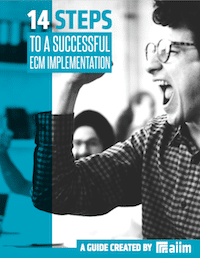The AIIM Blog
Keep your finger on the pulse of Intelligent Information Management with industry news, trends, and best practices.
Artificial Intelligence (AI) | Intelligent Information Management (IIM)
Earlier this fall, I had the pleasure of joining Chris McNulty on the Polaris Pathways podcast alongside Andrew Borg from Synozur to discuss how AI is transforming the nonprofit sector. Chris is AIIM's Treasurer and a member of our Board of Directors, so the conversation felt like a natural extension of the strategic discussions we've been having about AI's role in our industry. We covered everything from governance gaps to the emerging "frontier firm" model, and I wanted to share some key takeaways particularly relevant to associations and information management practitioners.
Share
Artificial Intelligence (AI) | Information Governance
As information management professionals, we deal with the continuous evolution of technologies that shape our industry, profession, and areas of practice. Today, AI stands as the latest "shiny new ball" in a long line of transformative technologies that promise to revolutionize how we handle information, identify opportunities, and manage risk.
Share

Making an ECM implementation successful requires planning and attention to detail. The best way to create the right solution is to identify organizational goals and priorities. Learn how to manage a successful implementation in our free guide.
Artificial Intelligence (AI) | Intelligent Information Management (IIM)
I recently had the opportunity to sit down with The Association Adviser podcast to discuss one of the most critical questions facing organizations today: how do we responsibly integrate AI into our operations? The episode, "AI is Here - Is Your Association Ready?", is now live, and I wanted to share some key insights from our conversation. As information management practitioners, we're not just dealing with technology adoption—we're navigating fundamental questions about how AI will reshape our organizations, our workforce, and our relationships with stakeholders. Here are some of the key questions (and my answers) that I believe information leaders should be asking right now.
Share
Artificial Intelligence (AI) | Document Management | Intelligent Document Processing | Intelligent Information Management (IIM)
I'm excited to share highlights from our first AIIM Trade Member Think Tank session, held on July 24, 2025. We launched this program to create a dedicated space for our vendor community to discuss market trends, share insights, and collaborate on advancing the information management industry.
Share
Artificial Intelligence (AI) | Intelligent Document Processing
Enterprise content management has evolved but complexity has accelerated even faster.
Share
Artificial Intelligence (AI) | Automation | Business Process Management (BPM) | Intelligent Document Processing | Intelligent Information Management (IIM)
As we leave the hazy days of summer behind us and head into the fourth quarter, I'm reflecting on what has truly been a summer of content at AIIM. Our partners and AIIM have been hard at work developing new resources that address some of the most critical challenges facing IT and information leaders today.
Share